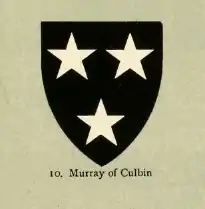Richard de Moravia
Richard de Moravia or Richard de Moray of Culbin or of Cubyn,[2] was a Scottish nobleman famed for his victory over the Vikings at the Battle of Embo which took place in Sutherland, Scotland in 1245.[3]
Richard de Moravia | |
|---|---|
| Lord of Culbin and Skelbo | |
| Died | c.1245 |
| Buried | Dornoch Cathedral, Dornoch, Sutherland |
| Residence | Skelbo Castle, Dornoch, Sutherland |
| Noble family | Murray family |
| Spouse(s) | Marjorie de Lascelles |
| Issue | Alexander William Malcolm Patrick. |

Origins
Richard was a son of Murdac (Muiredach), son of Alexander de Moravia.[4] This is proven in a charter from Abbot of Dunfermline, which identifies Richard as "Ric de Moravia fil Murdaci filii Alexandri de Moravia".[5]
He was also either the cousin,[6][7] or nephew,[8][7] of Hugh or Hugo de Moravia, also known as Hugh Freskin,[7] who was the first Lord of Sutherland and whose son was William de Moravia, 1st Earl of Sutherland (d.1284).[7][6] Richard's brother was Gilbert de Moravia (d.1245) who was Bishop of Caithness.[2][7] Gilbert is also known to have had an older brother John, and a younger brother, Simon.[9]
Castle and lands
Richard de Moravia received from his elder brother, Gilbert, all of the lands that Gilbert had received from Hugo Freskyn,[2] (also recorded as Hugo de Moravia) and the charter was confirmed by Alexander II of Scotland.[2] Richard was also given Skelbo Castle by his brother Gilbert in 1235.[10] He also held lands at Kincorth, Kintessoch, Kildun, Ethder, Calder, Newton, Invershin, Ferrinbuscay and Assynt.[11] His wife Marjorie, brought lands at Naughton as part of her dowry.[11]
Battle of Embo

William, Earl of Sutherland asked Richard de Moravia to engage a party of Danes (Vikings) who had landed at Littleferry, Sutherland until the Earl could come to his aid with a stronger force.[12] The plan worked and the Danes were routed by the arrival of the Earl.[12][6] However, Richard was killed during the battle.[12] The Earl then arranged for Richard's body to be interred in Dornoch Cathedral and his damaged sarcophagus can still be seen there today.[12] This was known as the Battle of Embo and took place in 1245.[3]
Family and descendants
Richard de Moravia married Marjorie Lascelles,[13] widow of Peter Hay, she was the daughter and heiress of Alan de Lascelles. They had four sons: Sir Alexander, William, Sir Malcolm, and Sir Patrick.[14]
Their great-grandson Alan;[13] whose son was Reginald; whose son was Gilbert.[2] Gilbert married Eustachia, daughter of Kenneth de Moravia, 4th Earl of Sutherland.[2] Their son was Walter whose daughter and heiress was Egidia de Moravia who carried the estates of Cubyn (Culbin) and Skelbol (Skelbo) into the Kinnaird family.[2]
Richard de Moravia is also believed to have been the ancestor of the Murray of Aberscross family in Sutherland.[15][16][6] The surname de Moravia meaning "of Moray" or "of Murray".[17]
The Murrays of Culbin and Pulrossie were also descendants of Richard.[18][19] The Murray of Culbin coat of arms is recorded as Sable, three stars argent.[1]
References
- Johnston, G. Harvey (George Harvey), 1860-1921 (1910). The Heraldry of the Murrays : with notes on all the males of the family, descriptions of the arms, plates and pedigrees. pp. 104–106.
Quoting: Forman's MS, Lyon Office, c. 1566
{{cite book}}: CS1 maint: multiple names: authors list (link) - Innes, Cosmo (1837). Registrum Episcopatus Moraviensis. Vol. 58. Edinburgh: Bannatyne Club. p. Xxxiii. Retrieved 30 January 2021.
- Simpson, William Douglas (1922). "The Cathedrals of Moray and Caithness". A Forgotten Aberdeenshire Monastery. Aberdeen University Press. p. 2. Retrieved 14 October 2020.
- Scottish Notes and Queries, Volume 2. D. Wyllie and Son, 1901. pp.130-131.
- Transactions of the Gaelic Society of Inverness, Volume 25, Gaelic Society of Inverness, 1907.
- "Early History of Clan Murray (Clann Mhoraidh) in New Scotland (Nova Scotia)". chebucto.ns.ca. Retrieved 11 February 2018.
- Rose, Mr D. Murray. Notes on the family of De Moravia, or Moray, Part 1. Retrieved 11 February 2018.
- Atholl, John James Hugh Henry Stewart-Murray (1908). Chronicles of the Atholl and Tullibardine Families. Vol. I. Edinburgh: Privately printed at the Ballantyne Press. pp. 1-2. Retrieved 13 October 2020.
In the "Chartulary of Moray," Gilbert de Moravia is called son of Lord Duffus, who from the date is assumed to be William son of Freskin
- "People of Medieval Scotland - Gilbert Murray, Bishop of Caithness (d.1245)". poms.ac.uk. Retrieved 10 April 2021.
- Fraser, William (1892). The Sutherland Book. Vol. 3. Edinburgh. pp. 6-8.
{{cite book}}: CS1 maint: location missing publisher (link) - "The Genealogy of the Murrays of Culbin". kinnaird.net. Retrieved 13 April 2021.
- "Norse Invaders". historylinks.org.uk. Retrieved 2 February 2018.
- McAndrew, Bruce (2006). Scotland's Historic Heraldry. Woodbridge, UK: The Boydell Press. p. 440.
- Notes and Queries. Oxford University. 1905. p. 242.
- Bulloch, John Malcolm (1907). House of Gordon. Aberdeen: New Spalding Club. pp. 6-7. Retrieved 23 January 2023.
Morays of Aberscors
- Shaw, Lachlan (1827). The History of the Province of Moray. Moray, Scotland: J. Grant. p. 473. Retrieved 11 January 2020.
Richard de Moravia ancestor of Sutherland Murrays
- Sutherland, Malcolm (1996). A Fighting Clan, Sutherland Officers: 1250 – 1850. Avon Books. p. 3. ISBN 1-897960-47-6.
- McAndrew, Dr Bruce (2010). "Heraldic investigations anent early Murray genealogy". Society of Antiquaries of Scotland: 145–164. Retrieved 13 October 2020.
{{cite journal}}: Cite journal requires|journal=(help) - Rose, Hew; Shaw, Lachlan; Innes, Cosmo (1848). A Genealogical Deduction of the family of Rose of Kilravock. Edinburgh: The Spalding Club. p. 64. Retrieved 13 October 2020.